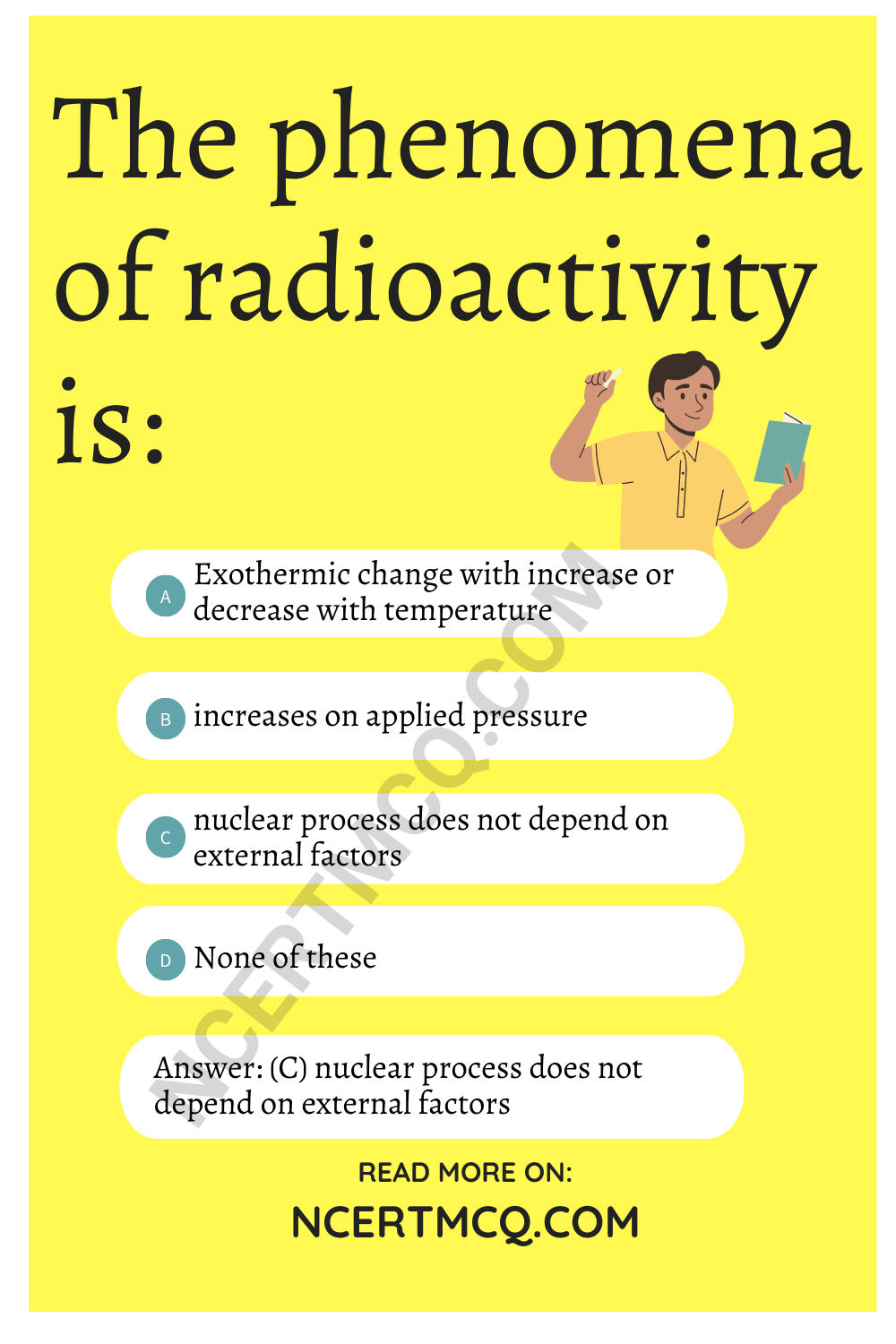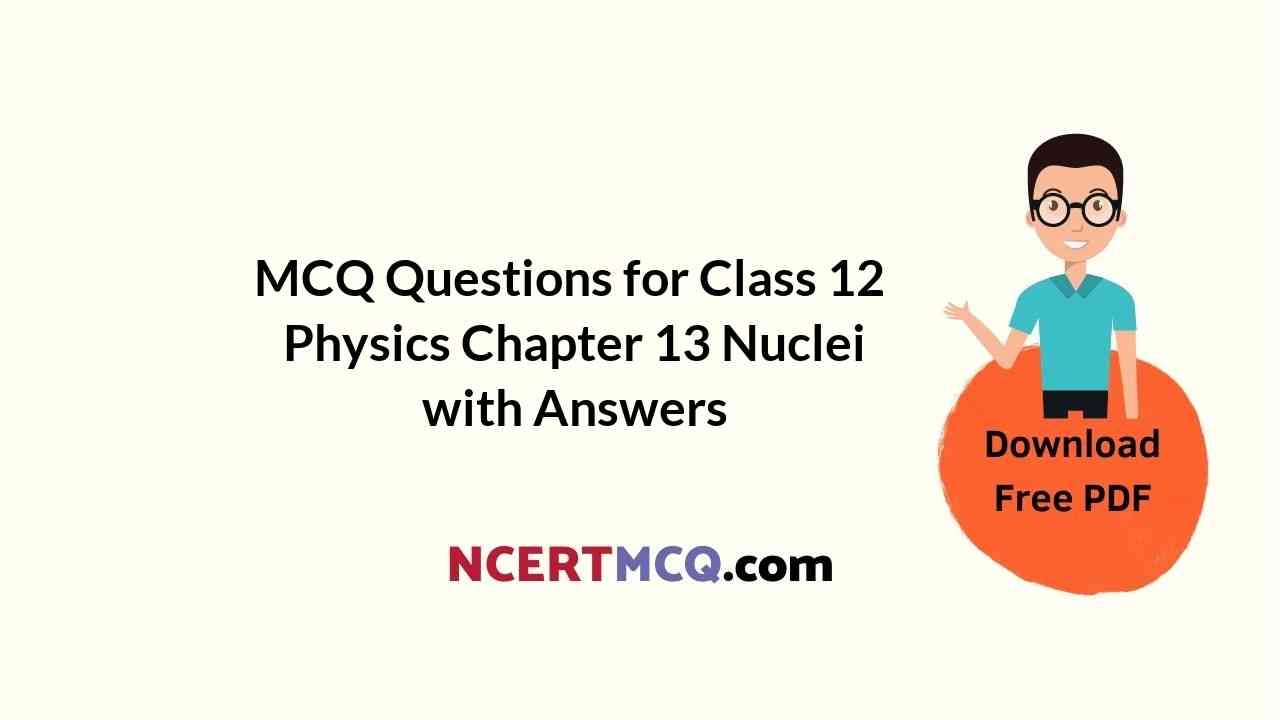Check the below NCERT MCQ Questions for Class 12 Physics Chapter 13 Nuclei with Answers Pdf free download. MCQ Questions for Class 12 Physics with Answers were prepared based on the latest exam pattern. We have provided Nuclei Class 12 Physics MCQs Questions with Answers to help students understand the concept very well.
Class 12 Physics Chapter 13 MCQ With Answers
Physics Class 12 Chapter 13 MCQs On Nuclei
MCQ On Nuclear Forces Class 12 Chapter 13 Question 1.
How many electrons are contained in \(_{92}^{238}\)U nucleus?
(a) 92
(b) 146
(c) 238
(d) 0
Answer
Answer: (d) 0
Nuclear Forces Are MCQ Class 12 Chapter 13 Question 2.
Chadwick was awarded the Nobel prize in Physics in 1935 for his discovery of:
(a) electron
(b) proton
(c) neutron
(d) None of these
Answer
Answer: (c) neutron
Nuclei Class 12 MCQ Chapter 13 Question 3.
The density of a nucleus is of the order of:
(a) 1015 kg m-3
(b) 1018 kg m-3
(c) 1017 kg m-3
(d) 1016 kg m-3
Answer
Answer: (c) 1017 kg m-3
Nuclear Drop Model Assumes MCQ Class 12 Chapter 13 Question 4.
In the given reaction:
\(_{Z}^{A}\)X → \(_{Z+1}^{A}\) Y → \(_{Z-1}^{A-4}\) K → \(_{Z-1}^{A-4}\) K radioactive radiations are emitted in the sequence
(a) α, β, γ
(b) β, α, γ
(c) γ, α, β
(d) β, γ, α
Answer
Answer: (b) β, α, γ
Nuclear Force Is MCQ Class 12 Chapter 13 Question 5.
When the mass of a sample of a radioactive substance decreases, the mean life of the sample:
(a) increases
(b) decreases
(c) remain unchanged
(d) first decreases then increases
Answer
Answer: (c) remain unchanged

MCQ On Nuclei Class 12 Chapter 13 Question 6.
Alpha particle emitted from a radioactive material are:
(a) Helium nuclei
(b) Hydrogen nuclei
(c) Lithium nuclei
(d) None of the above
Answer
Answer: (a) Helium nuclei
Nuclei MCQ Class 12 Chapter 13 Question 7.
The half life of a radioactive decay is n times its mean life, n is equal to:
(a) 0.6930
(b) 0.0693
(c) \(\frac{1}{0.6930}\)
(d) 0.3070
Answer
Answer: (a) 0.6930
MCQ On Atoms And Nuclei Class 12 Chapter 13 Question 8.
Rutherford is the unit of:
(a) radioactivity
(b) energy
(c) photoelectric current
(d) magnetic field
Answer
Answer: (a) radioactivity
Chapter 13 Physics Class 12 MCQs Question 9.
According to Yukawa’s theory of nuclear forces, the origin of nuclear force between nucleons is due to the exchange of
(a) mesons
(b) photons
(c) electrons
(d) positrons
Answer
Answer: (b) photons
Question 10.
An electron and a positron each having a mass equivalent to 0.53 MeV annihilate each other and produce a photon. The minimum energy of the photon is.
(a) 0.53 MeV
(b) 1.06 MeV
(c) 2.12 MeV
(d) zero
Answer
Answer: (b) 1.06 MeV
Question 11.
The wavelength of y-rays is of the order of:
(a) 10-8 m
(b) 10-5 m
(c) 10-11 m
(d) 10-22 m
Answer
Answer: (c) 10-11 m
Question 12.
Radius of 1st Bohr orbit is a0 (= 0.529 Å) What is the radius of 2nd Bohr orbit?
(a) 10-8
(b) 2a0
(c) 4a0
(d) 2√2a0
Answer
Answer: (c) 4a0
Question 13.
The ground state energy of Hydrogen atom is -13.6 eV. What is the potential energy of electron in this state?
(a) 0 eV
(b) -13.6 eV
(c) 2 eV
(d) -27.2 eV
Answer
Answer: (d) -27.2 eV
Question 14.
Which of the following atoms has the lowest ionization potential?
(a) \(_{8}^{8}\)O
(b) \(_{7}^{14}\)N
(c) \(_{55}^{133}\)Cs
(d) \(_{18}^{40}\)Ar
Answer
Answer: (c) \(_{55}^{133}\)Cs
Question 15.
The Bohr model of atom:
(a) assumes that the angular momentum of electron is quantized
(b) uses Einstein’s photoelectric equation
(c) predicts continuous emission spectra for atoms
(d) predicts the same emission spectra for all types of atoms
Answer
Answer: (a) assumes that the angular momentum of electron is quantized
Question 16.
Nuclear force is:
(a) strong, short range and charge independent force
(b) charge independent, attractive and long range force
(c) strong, charge dependent and short range attractive force
(d) long range, change dependent and attractive force
Answer
Answer: (a) strong, short range and charge independent force
Question 17.
If radio active nuclei emits β-particle, then mass-number:
(a) increased by 1 unit
(b) decreases by 1 unit
(c) increases by 2 unit
(d) decreases by 2 unit
Answer
Answer: (a) increased by 1 unit
Question 18.
An alpha particle is emitted from \(_{88}\)Ra\(^{226}\), then the product nuclei has:
(a) Z = 84, A = 224
(b) Z = 86, A = 224
(c) Z = 86, A = 222
(d) Z = 82, A = 222
Answer
Answer: (c) Z = 86, A = 222
Question 19.
X-ray was discovered by :
(a) Becqueral
(b) Marie curie
(c) Roengton
(d) Vanlaw
Answer
Answer: (c) Roengton
Question 20.
Fusion takes place at high temperature because:
(a) Atom are ionised at high temperature
(b) Molecules break up at high temperature
(c) Nuclei break up at high temp.
(d) Kinetic energy is high enough to overcome repulsion between nuclei
Answer
Answer: (d) Kinetic energy is high enough to overcome repulsion between nuclei
Question 21.
The order of nuclear density is :
(a) 103
(b) 1017
(c) 106
(d) None
Answer
Answer: (b) 1017
Question 22.
The isotope generally used for the treatment of cancer is:
(a) I131
(b) Hg197
(c) O15
(d) Co60
Answer
Answer: (d) Co60
Question 23.
What percentage of radioactive substance is left after 5 half lives?
(a) 3.125%
(b) 6.25%
(c) 12.33%
(d) 31%
Answer
Answer: (a) 3.125%
Question 24.
Mass is converted into energy according to the relation:
(a) E = me²
(b) E = mgh
(c) E = \(\frac{3}{2}\)me²
(d) E = \(\frac{mgH}{c^2}\)
Answer
Answer: (a) E = me²
Question 25.
The helium atom does not contain
(a) two protons
(b) two electrons
(c) two neutrons
(d) six nucleons
Answer
Answer: (d) six nucleons
Question 26.
The more readily fissionable isotope of uranium has an atomic mass of:
(a) 234
(b) 235
(c) 236
(d) 238
Answer
Answer: (b) 235
Question 27.
Energy of electron in the 1st orbit of H-atom is:
(a) -13.6 MeV
(b) -13.6 eV
(c) -13.6 J
(d) 13.6 J
Answer
Answer: (b) -13.6 eV
Question 28.
The mass no. of a nucleus is M and its atomic no. is Z. The number of neutrons in the nucleus is :
(a) M – Z
(b) M
(c) Z
(d) M + Z
Answer
Answer: (a) M – Z
Question 29.
The phenomena of radioactivity is:
(a) Exothermic change with increase or decrease with temperature
(b) increases on applied pressure
(c) nuclear process does not depend on external factors
(d) None of these
Answer
Answer: (c) nuclear process does not depend on external factors

Question 30.
When one gm of mass is converted into energy, it is equal to:
(a) 103 kWh
(b)109 kWh
(c) 1010 kWh
(d) 1011 kWh
Answer
Answer: (a) 103 kWh
We hope the given NCERT MCQ Questions for Class 12 Physics Chapter 13 Nuclei with Answers Pdf free download will help you. If you have any queries regarding Nuclei CBSE Class 12 Physics MCQs Multiple Choice Questions with Answers, drop a comment below and we will get back to you soon.
Class 12 Physics MCQ:
- Electric Charges and Fields Class 12 MCQ
- Electrostatic Potential and Capacitance Class 12 MCQ
- Current Electricity Class 12 MCQ
- Moving Charges and Magnetism Class 12 MCQ
- Magnetism and Matter Class 12 MCQ
- Electromagnetic Induction Class 12 MCQ
- Alternating Current Class 12 MCQ
- Electromagnetic Waves Class 12 MCQ
- Ray Optics and Optical Instruments Class 12 MCQ
- Wave Optics Class 12 MCQ
- Dual Nature of Radiation and Matter Class 12 MCQ
- Atoms Class 12 MCQ
- Nuclei Class 12 MCQ
- Semiconductor Electronics: Materials, Devices and Simple Circuits Class 12 MCQ
- Communication Systems Class 12 MCQ
